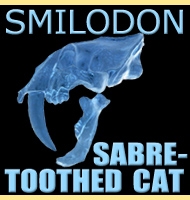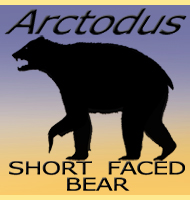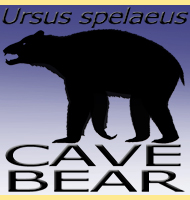


Ursus arctos crowtheri
a.k.a. Atlas bear, Atlas brown bear
Name: Ursus
arctos crowtheri.
Phonetic: Ur-sus ark-tos krow-fe-ree.
Named By: Heinrich Rudolf Schinz - 1844.
Classification: Chordata, Mammalia, Carnivora,
Ursidae.
Species: U. arctos crowtheri.
Diet: Herbivore/omnivore?
Size: No larger than a black bear, which are known
to range from 120-200 centimetres long, 10-105 centimetres high
at the shoulder.
Known locations: The Atlas Mountains of north
Africa. Especially well known from Morocco.
Time period: Holocene, possibly going extinct at
some point in the late nineteenth century.
Fossil representation: Numerous fossils. Records
exist of living bears.
The
Atlas bear (Ursus arctos crowtheri) is today
considered to be an
extinct sub species of the brown bear (Ursus arctos);
although some
researchers think that it should be treated as a distinct species in
its own right. The Atlas bear seems to have been the last of the
African bears (Agriotherium
and Indarctos
lived much earlier),
and the only one so far known to have been naturally exclusive to the
African continent. Though a relative of the huge brown bear, the
Atlas bear is actually noted as being smaller than the black bear
(Ursus americanus). The coat of long ten to
twelve centimetre long
hair was a dark brown almost black on top, but red-orange
underneath. Both snout and claws are reported as being
proportionately shorter than the black bear. The Atlas bear seems to
have been mostly herbivorous with reports suggesting it fed upon the
more nutritious parts of plants such as roots, nuts and even acorns.
However as a group bears are noted as being omnivorous, and while
many have a predilection towards one kind of food over another, Atlas
bears would have likely been biologically capable of eating meat as
well.
As
with far too many animals the Atlas bear seems to have gone extinct
entirely from human contact, especially from such activities as
trapping and hunting. The atlas bear was known to the Romans, who
according to historical reports, captured large numbers of these
bears to fight in gladiatorial arenas, either against professional
hunters, or pitted against criminals that were punished by being
thrown to wild animals. Some Roman mosaics also depict creatures
which may well represent Atlas bears. In 1830 the king of Morocco
had at least one Atlas bear living in captivity and also that year
supplied a bear to the Zoological garden of Marseille which then became
the holotype of the species. The last Atlas bear to be killed by
hunters is often reported to have been killed in 1870 in the Tetuan
Mountains. Today the Atlas bear is officially recorded as being
extinct, probably disappearing in the late nineteenth century.
Despite
this however, sightings of bear-like animals are sometimes reported
in regions where the Atlas bear used to live, with some speculating
that it maybe the mythical ‘Nandi bear’. Unfortunately however,
no bodies or other evidence (hair, scat, dens, etc.) of
still living bears have so far been found. Assuming that the
sightings are genuine, then it’s possible that they could simply be
cases of mistaken identity.
Further reading
- Ancient DNA evidence for
the loss of a highly divergent brown bear clade during historical
times. - Molecular Ecology 17 (8): 1962–1970. S. Calvignac, S. Hughes,
C. Tougard, J. Michaux, M. Thevenot, M. Philippe, W. Hamdine & C.
Hanni - 2008.
Random favourites
 |
 |
 |
 |




